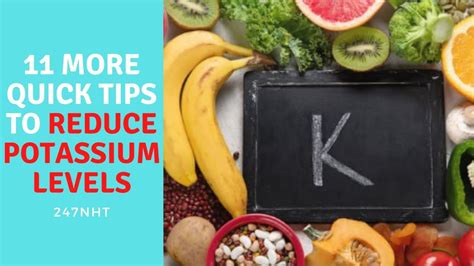How to Reduce Your Potassium: A Guide to Dietary Changes and Lifestyle Adjustments
High potassium levels, or hyperkalemia, can be a serious health concern, especially for individuals with kidney disease. While a healthy potassium intake is crucial, managing high levels requires careful attention to diet and lifestyle. This guide provides actionable steps to help you safely lower your potassium. Remember to always consult your doctor or a registered dietitian before making significant dietary changes, especially if you have pre-existing health conditions.
Understanding Potassium and its Importance
Potassium is an essential electrolyte vital for numerous bodily functions, including nerve signals, muscle contractions, and maintaining a healthy heartbeat. Most people obtain sufficient potassium through a balanced diet. However, those with kidney disease or certain other medical conditions may struggle to eliminate excess potassium, leading to potentially dangerous levels.
Dietary Strategies to Reduce Potassium Intake
Reducing potassium intake primarily involves careful food selection. Here's a breakdown of strategies:
1. Limit High-Potassium Foods
Many common foods are surprisingly high in potassium. Avoid or drastically reduce consumption of the following:
- Fruits: Bananas, oranges, melons, apricots, prunes, raisins, avocados, and tomatoes (especially tomato juice).
- Vegetables: Potatoes (especially with skin), sweet potatoes, spinach, beet greens, mushrooms, and broccoli.
- Legumes: Beans, lentils, and peas.
- Dairy: Milk, yogurt, and some cheeses.
- Nuts and Seeds: Almonds, cashews, sunflower seeds, and pumpkin seeds.
- Processed Foods: Many processed foods contain added potassium, so always check food labels.
2. Choose Low-Potassium Alternatives
Instead of eliminating entire food groups, explore low-potassium substitutes:
- Fruits: Apples, cranberries, blueberries (in moderation), and pears (peeled).
- Vegetables: Cauliflower, cabbage, green beans (in moderation), and zucchini.
- Dairy: Some low-potassium milk alternatives are available. Check labels carefully.
- Protein: Lean meats (chicken, fish), and eggs are generally lower in potassium.
3. Prepare Foods Carefully
Food preparation methods can impact potassium levels:
- Peeling: Peeling fruits and vegetables can significantly reduce potassium content.
- Soaking and rinsing: Soaking and rinsing grains like rice and beans can help leach out some potassium.
- Boiling: Boiling vegetables and discarding the water can lower potassium levels. However, this also removes essential nutrients, so moderation is key.
Lifestyle Adjustments for Potassium Management
Beyond diet, lifestyle adjustments can play a role in managing potassium levels:
- Hydration: Drinking plenty of water helps your kidneys flush out excess potassium.
- Regular Exercise: Maintaining a healthy weight through regular physical activity contributes to overall health and kidney function.
- Medication Management: Strictly adhere to any prescribed medications for managing potassium levels. This is crucial, especially if you're taking medications that can influence potassium levels.
Monitoring Potassium Levels
Regular monitoring of your potassium levels through blood tests is essential, especially if you're at risk of hyperkalemia or have kidney disease. This allows for timely adjustments to your diet and medication as needed. Your doctor will guide you on the appropriate frequency of testing.
Conclusion
Reducing potassium intake requires a concerted effort to modify your diet and lifestyle. By carefully selecting low-potassium foods, preparing meals strategically, and maintaining a healthy lifestyle, you can effectively manage your potassium levels and improve your overall health. Remember, consistent communication with your healthcare provider is vital throughout this process. They can provide personalized guidance based on your individual needs and health condition.
